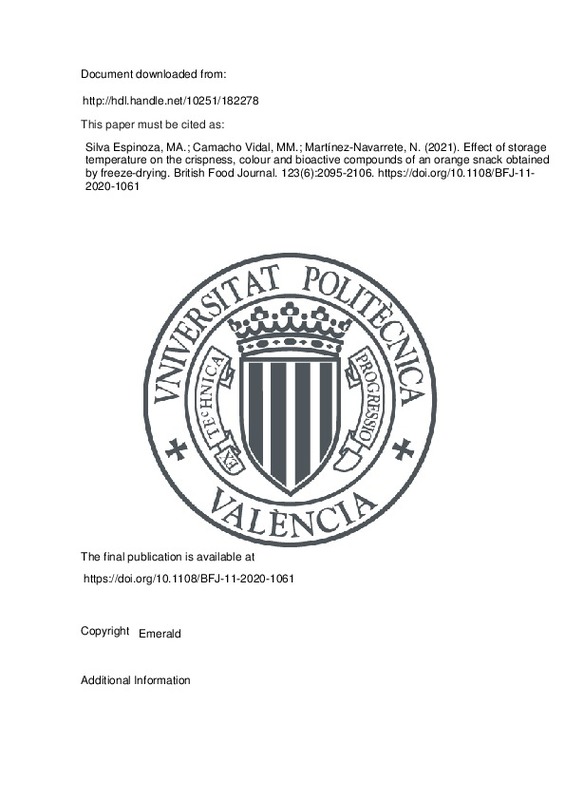JavaScript is disabled for your browser. Some features of this site may not work without it.
Buscar en RiuNet
Listar
Mi cuenta
Estadísticas
Ayuda RiuNet
Admin. UPV
Effect of storage temperature on the crispness, colour and bioactive compounds of an orange snack obtained by freeze-drying
Mostrar el registro sencillo del ítem
Ficheros en el ítem
| dc.contributor.author | Silva Espinoza, Marilú Andrea
|
es_ES |
| dc.contributor.author | Camacho Vidal, Mª Mar
|
es_ES |
| dc.contributor.author | Martínez-Navarrete, Nuria
|
es_ES |
| dc.date.accessioned | 2022-04-28T18:05:06Z | |
| dc.date.available | 2022-04-28T18:05:06Z | |
| dc.date.issued | 2021-06-28 | es_ES |
| dc.identifier.issn | 0007-070X | es_ES |
| dc.identifier.uri | http://hdl.handle.net/10251/182278 | |
| dc.description.abstract | [EN] Purpose A healthy and easy-to-use orange snack obtained from the freeze-dried orange pulp puree is proposed. Once the commercial packaging of the snack has been opened, the effect of conventional home storage temperature on its physicochemical properties and on the content of bioactive compounds has been studied. This research aims to recommend the consumer, and therefore the manufacturer, the best conditions for home storage of this product, keeping its nutritional quality and antioxidant capacity, as well as maintaining its colour and crispness. Design/methodology/approach The water content, water activity, hygroscopicity, crispness, colour, vitamin C, beta-carotene, total phenolic compounds and antioxidant activity were characterised both when the orange snack was newly obtained and after one, two and six months of storage inside zipper bags, at 4 and 20 oC. Findings The results indicated that, in these conditions, the orange snack increased its water content, causing a loss in both its porosity and its characteristic crispness. Nevertheless, the bioactive compounds remained stable throughout the storage period, with the exception of beta-carotene, the content of which decreased markedly when the orange snack was stored at 20 oC. Originality/value Few studies have evaluated the stability of food products during home storage. The findings showed that the maximum storage time to ensure a proper texture of the orange snack studied is between two and six months, both at 4 and 20 oC. However, from the point of view of the conservation of both vitamin C and, especially, of beta-carotene, it is recommended that this product be stored in refrigeration. | es_ES |
| dc.description.sponsorship | The authors thank the Ministerio de Economia, Industria y Competitividad of Spain for the financial support given through the Project AGL 2017-89251-R (AEI/FEDER-UE) and the Ministerio de Universidades for the FPU grant (FPU14 / 02633) awarded to Ms. Andrea Silva. | es_ES |
| dc.language | Inglés | es_ES |
| dc.publisher | Emerald | es_ES |
| dc.relation.ispartof | British Food Journal | es_ES |
| dc.rights | Reserva de todos los derechos | es_ES |
| dc.subject | Crispness | es_ES |
| dc.subject | Colour | es_ES |
| dc.subject | Vitamin C | es_ES |
| dc.subject | Total phenolic compounds | es_ES |
| dc.subject | Beta-carotene | es_ES |
| dc.subject | Zipper bag | es_ES |
| dc.subject | Orange puree | es_ES |
| dc.subject | Gum Arabic | es_ES |
| dc.subject | Bamboo fibre | es_ES |
| dc.subject | Antioxidant activity | es_ES |
| dc.subject.classification | TECNOLOGIA DE ALIMENTOS | es_ES |
| dc.title | Effect of storage temperature on the crispness, colour and bioactive compounds of an orange snack obtained by freeze-drying | es_ES |
| dc.type | Artículo | es_ES |
| dc.identifier.doi | 10.1108/BFJ-11-2020-1061 | es_ES |
| dc.relation.projectID | info:eu-repo/grantAgreement/AEI/Plan Estatal de Investigación Científica y Técnica y de Innovación 2013-2016/AGL2017-89251-R/ES/IMPACTO DE LAS CONDICIONES DE LIOFILIZACION EN LA CALIDAD DE PRODUCTOS DE FRUTA. INFLUENCIA DE LA MATRIZ/ | es_ES |
| dc.relation.projectID | info:eu-repo/grantAgreement/MECYD//AP2014%2F02633//AYUDA CONTRATO FPU 2014-SILVA ESPINOZA/ | es_ES |
| dc.rights.accessRights | Abierto | es_ES |
| dc.contributor.affiliation | Universitat Politècnica de València. Departamento de Tecnología de Alimentos - Departament de Tecnologia d'Aliments | es_ES |
| dc.description.bibliographicCitation | Silva Espinoza, MA.; Camacho Vidal, MM.; Martínez-Navarrete, N. (2021). Effect of storage temperature on the crispness, colour and bioactive compounds of an orange snack obtained by freeze-drying. British Food Journal. 123(6):2095-2106. https://doi.org/10.1108/BFJ-11-2020-1061 | es_ES |
| dc.description.accrualMethod | S | es_ES |
| dc.relation.publisherversion | https://doi.org/10.1108/BFJ-11-2020-1061 | es_ES |
| dc.description.upvformatpinicio | 2095 | es_ES |
| dc.description.upvformatpfin | 2106 | es_ES |
| dc.type.version | info:eu-repo/semantics/publishedVersion | es_ES |
| dc.description.volume | 123 | es_ES |
| dc.description.issue | 6 | es_ES |
| dc.relation.pasarela | S\431282 | es_ES |
| dc.contributor.funder | MINISTERIO DE EDUCACION | es_ES |
| dc.contributor.funder | AGENCIA ESTATAL DE INVESTIGACION | es_ES |
| dc.contributor.funder | European Regional Development Fund | es_ES |







![[Cerrado]](/themes/UPV/images/candado.png)

